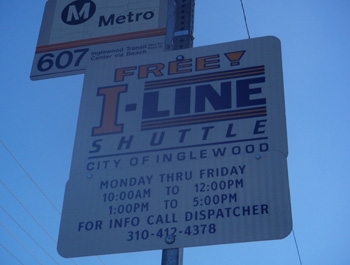 Inglewood residents were relieved on Monday when the city’s free trolley service added an additional seven daily stops throughout the city. This expansion follows a year-long protest by city residents to keep the service from being eliminated by budget cuts.
Inglewood residents were relieved on Monday when the city’s free trolley service added an additional seven daily stops throughout the city. This expansion follows a year-long protest by city residents to keep the service from being eliminated by budget cuts.
The I-Line Trolley Route was approved for termination one year ago, due to required expense cuts. Since Sept. 2009 residents of Inglewood have petitioned to both continue the service and add new stops at shopping areas.
“This new trolley route took a lot of work to bring about,” said Mavis Pilar, Inglewood resident and frequent user of the I-Line transportation service. “Last year the city wanted to remove it altogether, but they don’t realize the number of people in this city that get around by this free transportation.”
The current annual cost of the program is $107,000, according to the city’s Finance Department. About $65,000 of the expense is covered by grant funds, said Sabrina Barnes, the Parks, Recreation and Community Services director.
Six stops were eliminated from the old route because “no one used them,” said Inglewood City Councilman Eloy Morales, Jr. in an interview. “Now, I hope we can continue to offset the costs and encourage as much ridership as possible.”
After city staff conducted surveys, studied proposed routes and received recommendations from the Metropolitan Transportation Authority (MTA), City transportation and GIS engineers, the City Council approved the continuation of the I-Line Trolley Route, according to Sabrina Barnes, The Inglewood City Council approved the motion to keep and expand the shuttle on Aug. 10.
The route’s new configuration takes approximately one hour. It includes seven new stops, including one in the business district on Century and Crenshaw, and on Pincay Drive to accommodate Carlton Square and Briarwood. Other stops include Prairie and Hardy, Century and Doty, Century and Club, Century and Village, Crenshaw and Hardy, and 90th and West Carlton.
“We basically let them know that they need to cut funds from other places, and not from our daily lives and our paychecks. Because without that service, a lot of us would be stranded. How do they think we get to work?” Pilar said.
“I am glad that we did the surveys,” said Morales. “They showed that I-Trolley really works.”
The I-Line Trolley Shoppers Shuttle Service began in 1986, providing free transportation for all ages on a fixed route that connected shopping areas, public service agencies, the Inglewood Senior Center, five senior housing complexes, and connection points to the Metropolitan Transportation Authority (MTA) bus service. Since its beginning the length of the route has been modified five times in response to citizen petitions.
The Service is funded by City Proposition C funds and Proposition A Incentive grants from the MTA. These funds are purposed for parks, recreation and community services, senior transportation, contract services and general transportation.
Since the I-Line is granted by the MTA, the association’s staff has been involved in setting up data collection and reporting systems to evaluate the new route. They have also worked with the Public Works Department in acquiring and installing new signs, and producing road work needed to accommodate the new stops.
A statement released by the Inglewood Parks, Recreation and Community Services Department estimated a cost of $1,500 for new signs. This is the only major additional expense created by the new I-Line Trolley Service route.
Free Trolley service operates Monday through Friday from 10 a.m. to noon, and from 1 p.m. to 5 p.m. Each loop begins and ends at the Inglewood Senior Center, located at Vincent Park, 330 Centinela Avenue. Signs displaying the number to the trolley dispatch office are posted at the stops to offer easy access to information on the trolley’s location.














